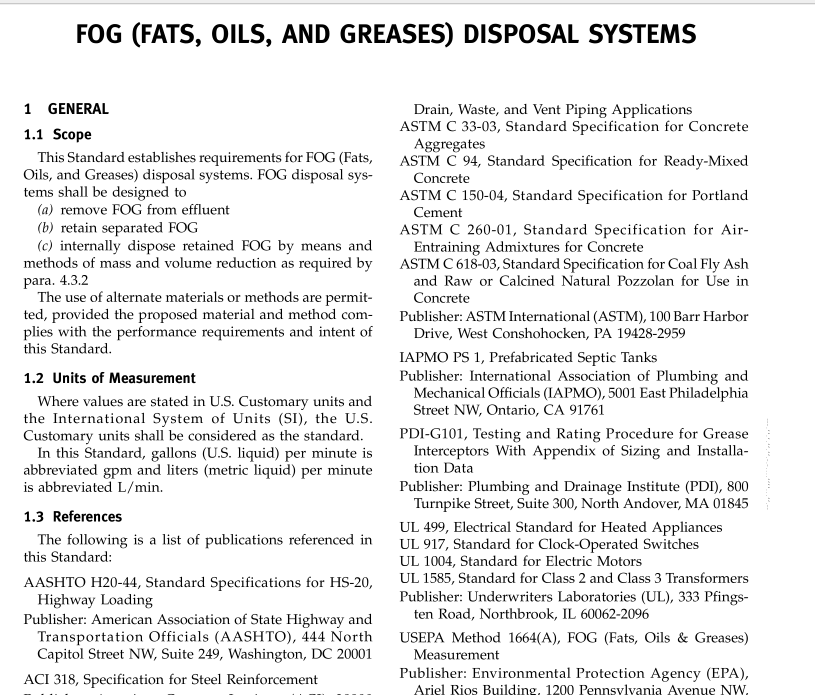ASME A112.14.6 pdf download

ASME A112.14.6 pdf download FOG (Fats, Oils, and Greases) Disposal Systems
3 SPECIAL REQUIREMENTS
3.1 Separation/Retention Efficiency FOG disposal systems shall have a minimum separa- tion/retention efficiency in accordance with ASME A112.14.3 or PDI-G101.
3.2 Application Documentation Each FOG disposal system shall be provided with complete applicationinstructions including, butnotlim- ited to, the following:
(a) flow control and/or vent requirements
(b) any separate trapping requirements
(c) elevation and accessibility requirements
(d) safety and health-related instructions
(e) wiring instructions to reference national or local codes
(f) clean-out locations
(g) instructions that show the clearances required for maintenance, cleaning, and prevention of hazards
3.3 Maintenance and Operation Documentation Each FOG disposal system shall be provided with maintenance and operation documentation, which include a troubleshooting guide as well as instructions for performing necessary servicing or obtaining outside servicing. Units shall be provided with complete mainte- nance and operating instructions.
3.4 Installation
3.4.1 Installation shall be in accordance with the manufacturer’s recommendations and the applicable plumbing codes.
3.4.2 Each unit shall be packaged with illustrated directions detailing correct installation procedures.
3.4.3 In buried applications of FOG disposal sys- tems, access to each system shall be provided. There shall be access for each 10 ft (3.03 m) of length for FOG disposal systems over 20 ft (6.1 m) long. Each access opening shall have a leak-resistant closure (i.e., lid) that cannot slide, rotate, or flip exposing the opening, and which does not require the use of mechanical fasteners and be of a vandal-resistant type.
3.4.4 Manholes, ifapplicable,shall extendto grade; have a minimum diameter size of20 in. (510 mm) diame- ter or 20 in. ✕ 20 in. (510 mm ✕ 510 mm); and shall be provided with a fitted, water-tight cover. Manholes shall be capable of withstanding all anticipated loads and comply with IAPMO PS-1, para. 4.7.1, which requires thatall manholes have aleak-resistantclosure that, when properly installed, cannot slide, rotate, or flip exposing the opening, and which does not require the use of mechanical fasteners.
4 TESTING
4.1 Water Test
4.1.2 Test Procedure. A sampling from each manu- facturer’s production run shall be water-tested. One sample shall be tested for each size FOG disposal system manufactured. Sample FOG disposal systems shall be assembled in accordance with the manufacturer’s instructions, set level, and water raised to the flow line of the outlet fitting.
4.1.3 Acceptance Criteria. FOG disposal systems shall show no leakage from section seams, pinholes, or other imperfections. Any leakage is cause for rejection.
4.1.3.1 When leakage occurs, additional water testing shall be made from new samples after corrective measures in production or installation have been com- pleted. Test reports shall show the total number of FOG disposal systems tested, number passing, number fail- ing, location, and cause ofleakage. Whenleakage occurs, corrective measures taken shall be reported.
4.2 Efficiency Test
4.2.1 Test Procedure. The hydraulic efficiency of the FOG internal disposal systems shall be determined in accordance with ASME A112.14.3 or PDl-G101. For flows exceeding PDI-G101 capacities, the efficiency shall be calculated as prescribed in para. 7.7 of PDI-G101. Hydraulic efficiency, as used here, is the FOG separation and retention efficiency ofthe FOG disposal system with the disposal function inactive. The separation and reten- tion efficiency of the FOG disposal system shall comply with the requirements of para. 7.8 of PDI-G101.
4.2.2 Acceptance Criteria. The minimum hydraulic efficiency shall be 90% or greater.
4.3 Performance Testing
4.3.1 Test Procedure. Test the FOG disposal system as follows:
(a) Measure the total liquid volume of the system at the point of discharge.
(b) Calculate the test flow rate (in gpm) by dividing the nameplate flow rate (in gpm) by 4.
(c) Install the system in accordance withthe manufac- turer’s instructions.
(d) Connect the inlet of the system to a potable water supply capable of providing the test flow rate at a tem- perature between 70°F and 76°F. Charge the system at the test flow rate, with FOG having a specific gravity of 0.875 ± 0.005, at 150°F being injected into the influent at the rate of 300 mg/L. Activate the disposal function and allow it to stabilize in accordance with the manufac- turer’s instructions.









